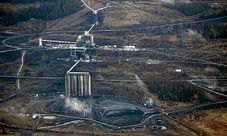The world map of Swiss mines
The world map of Swiss mines
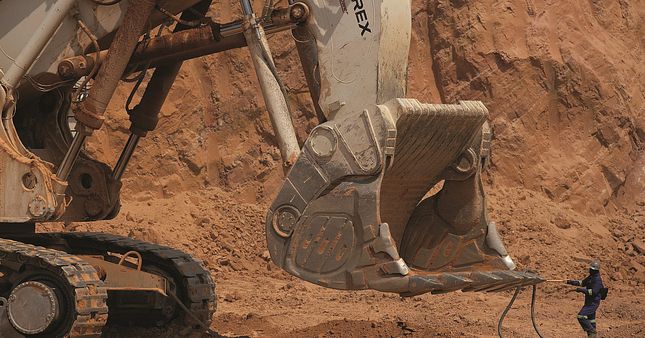
A tragedy at a Glencore mining concession highlights the dangers of the cobalt rush taking place in the DRC. Artisanal miners are risking their lives for a paltry share of the country’s resources.
There is something like an ancient feud between mine and miner. In Kolwezi, in the Democratic Republic of Congo (DRC), the pits continue to nibble away at the land, as multinational mining groups extract the precious copper and cobalt using explosives and excavators.
At times, the promises of the energy transition push metal prices to exorbitant levels. That is when, in one of the poorest regions in the world, thousands of Congolese are flocking to the concessions that large mining groups have secured for themselves. They’re digging with pickaxes to get a share of the spoils, hardly more than a few crumbs buried in tunnels 50 metres underground.
Unsurprisingly, accidents are a common occurrence. As happened on Thursday, 27 June 2019 at the site of the Kamoto Copper Company (KCC), a subsidiary of Glencore, where up to 2,000 miners were working. Two “artisanal” galleries located on an unexploited portion of the Zug-based group’s concession collapsed, turning daily work into a tragedy. Thirty independent miners lost their lives, according to Glencore. Estimates from the local Red Cross suggested up to 80 deaths. The Swiss multinational was quick to point out the illegal nature of their activity, which had no “links” to KCC’s operations.
Risks hardly matter when you are hungry. “It’s frightening down there,” explained one artisanal miner from Kolwezi, quoted by the Belgian public broadcaster RTBF. “It’s dangerous, but what choice do we have? There’s nothing else for us to do here.” The day after the fatal accident, the artisanal miners were already back at work, this time being pushed back by the Congolese army called in as reinforcements.
Sources
- Glencore Sustainability Report (2019), page 65, accessed 17.06.25.
- La Tribune Afrique (2019): RDC: le bilan s’alourdit après l’effondrement d’une mine de Glencore [DRC: the death toll rises after the collapse of a Glencore mine], accessed 17.06.25.
- RTBF (2023): Transition énergétique: au Congo, l’enfer des creuseurs de cobalt [Energy transition: in Congo, the hell of cobalt miners], accessed 17.06.25.
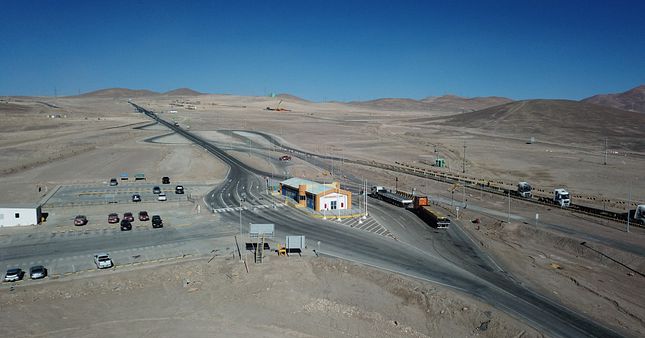
In the heart of the Atacama Desert, the mining group is overexploiting the valuable water resources needed for its copper mines, causing irreversible damage to the ecosystem in the process.
The Atacama Desert is one of the driest places on Earth. Right in the middle of it is a gaping hole, the Escondida copper mine, run by the Australian company BHP. It is located quite close to the “Punta Negra” salt flats, one of the few wet zones in the region.
But instead of handling groundwater reserves with care, BHP has systematically strained them for more than a decade, exceeding the maximum amount allowed in Chile. This was reported by the law enforcement agency CDE in 2020, after BHP had diverted three times the amount of water agreed with the government in the previous year. The agency brought charges against the mine operator for “continuous, cumulative, permanent and irreparable damage” to the ecosystem.
After BHP agreed to spend up to $93 million on reparations, the case was settled in 2021. This copper mine, which is the most productive by far in the world, and whose raw materials BHP sells through a trading company based in Zug, was allowed to continue production.
A few months later, a ruling issued by the First Environmental Court of Chile emphasized the strong pressure that BHP’s copper production exerts on the country’s scarce water resources. It ordered another BHP copper mine, Cerro Colorado, to stop pumping water immediately. The group discontinued its production there.
Nowadays, copper mining is no less water-intensive, but due to the energy transition, demand for and the price of copper have greatly increased. That is why BHP is keen to restart operations at Cerro Colorado and further expand all its Chilean mines. In the group’s view, the only thing standing in its way is red tape.
Sources:
- SMA (Chilean environmental enforcement agency) (2020): Antofagasta: SMA formula cargo grave a Minera Escondida por impacto sobre recurso hídrico [SMA files serious charge against Minera Escondida for impact on water resources]. Last accessed on 14th May 2025.
- State Defence Council (CDE) (2020): CDE interpone demanda por daño ambiental provocado en el Salar de Punta Negra. [CDE files lawsuit for environmental damage caused in the Salar de Punta Negra] Last accessed on 14th May 2025.
- Mongabay (2021): In Chile, a prickly coalition tries to bring a salt flat back to life. Last accessed on 14th May 2025.
- Reuters (2021): Chile court orders BHP’s Cerro Colorado copper mine to stop pumping from aquifer. Last accessed on 14th May 2025.
- Bloomberg (2025): BHP Gives Chile a $13 Billion Reason to Cut Red-Tape for Mines. Last accessed on 14th May 2025.
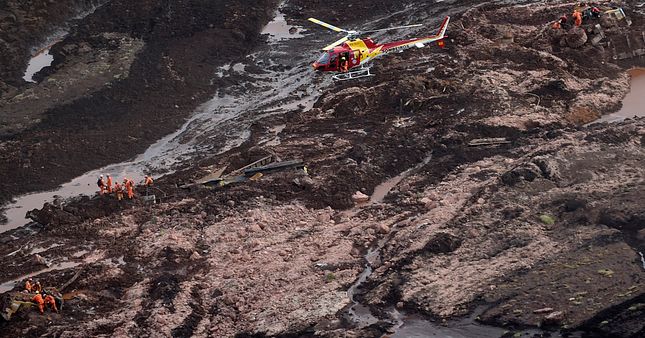
A mining dam in Brazil collapsed, causing the death of 272 people, which highlighted the gross negligence of mining giant Vale and the flaws in its safety controls.
This is one of the worst social and environmental disasters in Brazil’s history. It was just after 12.30 in the afternoon on 25 January 2019 in the Brumadinho region, located in the state of Minas Gerais. Most of the miners working for the Brazilian group Vale were having lunch in the canteen when a 13 million cubic-metre mudslide swooped down on them at a speed of up to 80 km/h. As the dykes of the dam upstream gave way, the tide of mud and mining waste violently swept away everything in its path – trees, embankments and the entire infrastructure. And it would claim 272 lives.
It was the second such collapse in the region in just over three years, again involving Vale. Official Brazilian statistics later listed some 200 constructions at risk, just like the Brumadinho dam, a quarter of which operated by Vale, which has been running its trading operations since 2006 from its subsidiary located in Saint-Prex, Switzerland.
The investigation conducted by Brazilian authorities quickly questioned the diligence of the technical inspections performed on this type of infrastructure. After having previously failed to certify the Brumadinho dam’s stability, Vale approached the German certification group TÜV Süd. The miner is under suspicion of having pressurized the certifier into giving it a clean bill. Despite the internal e-mails warning about the imminent threat posed by this situation, the Brazilian subsidiary of TÜV Süd finally certified the dam.
Vale now displays the message “We will never forget Brumadinho” on its website. Let’s hope they don’t.
Sources
- La séquence de la catastrophe (2019) [The sequence of the disaster (2019)], https://www.youtube.com/watch?v=Adk0AwcISHo, accessed 17.06.25.
- Swissinfo (2019): La colère contre le géant brésilien Vale passe par la Suisse [Anger against Brazilian giant Vale sweeps through Switzerland], accessed 17.06.25.
- Reuters (2020): Brazil’s Vale ordered to set aside $1.48 billion for Brumadinho dam damages, accessed 17.06.25.
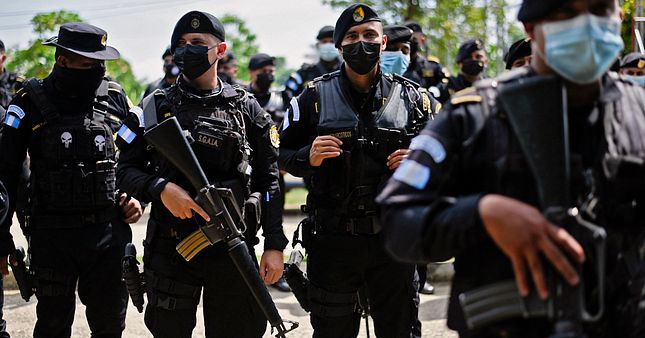
In a land scarred by violence, the Solway group continues to engage in its mining activities, with the complicity of the Guatemalan authorities and complete disregard for the rights of indigenous communities.
The Fénix mine has experienced nothing but conflict throughout its existence.
The nickel project was launched in the 1960s in north-eastern Guatemala, at the outbreak of a civil war (1960-1996) that resulted in more than 200,000 casualties. In 1978, the army was mobilized by the military regime in power at the time to repress any social movement and protect foreign investments. Some 700 members of the Q’eqchi’ indigenous community gathered in Panzós, a town about 40 kilometres from the mine, to protest the theft of their land. 53 unarmed people were massacred by gunfire.
In 2011, the Solway Investment Group, based in Zug, Switzerland, bought the mining assets from a Canadian company, whose management had been marred by accusations of forced evictions and physical or sexual violence. Fénix’s activities were restarted three years later via Solway’s local subsidiary, Compañía Guatemalteca de Níquel (CGN). But the Q’eqchi’ as the majority population in the region, said they had not been consulted, maintaining “their” Lake Izabal had been polluted by heavy metals.
According to the UN Declaration on the Rights of Indigenous Peoples, they must be consulted before “any project affecting their lands or territories and other resources”. In June 2020, the Constitutional Court of Guatemala ordered that the activities should cease until an environmental impact assessment had been performed and a legal consultation conducted with indigenous communities.
But extraction continued with the complicity of some Guatemalan politicians. In 2021, the country’s anti-riot police forced open the roadblocks set up by the demonstrators, which were blocking CGN trucks. Documents leaked from the Solway Group recently showed that executives knew that their mining activities were responsible for the pollution of Lake Izabal. The Group has also been accused of exerting pressure on the local community and on journalists, as well as of peddling influence against opponents of the Fénix project. A fisherman was killed by police during a protest in May 2017.
Sources
- Constitutional Court, Republic of Guatemala (2019), https://nimajpu.org/sentencias/wp-content/uploads/2021/05/Sentencia-MIna-Fe%CC%81nix-ORDINARIA_697-2019-2.pdf, accessed 17.06.25.
- Amnesty (2022): Le nickel de la honte [Nickel of shame], accessed 17.06.25.
- OCCRP (2022): Guatemalan Ministers Charged for Allowing Nickel Mine to Pollute Environment, accessed 17.06.25.
- Forbidden Stories (2019): A damning photo holds a Swiss–Russian mine accountable in Guatemala, accessed 17.06.25.

Despite its official climate commitments, Glencore continues to consolidate its presence in the sector, promoting the most polluting of all fossil fuels by buying new mines in Canada.
It’s a well-known saying: if you believe that, you’ll believe anything. And when it comes to making short-lived commitments, there is no-one better at it than Glencore.
In the wake of the Paris Agreement in late 2015, this Zug based commodities giant committed to gradually getting rid of its coal mines to achieve “net zero” CO2 emissions by 2050. In February 2019, it decided – in a move to reassure its investors – to “freeze” its coal production at 150 million tonnes per year. Finally, Glencore launched a hostile takeover bid for Canadian rival Teck Resources in 2023. The aim was to merge their assets to form a mega mining group and launch coal-related activities as a spin-off.
At the same time, however, Glencore was involved in purchasing Latin America’s largest open-pit mine in its entirety (Cerrejón, in 2021); got rrid of its annual production cap of 150 million tonnes, a ceiling that it had never reached anyway; and finally decided to buy, for nearly $7 billion, Teck's coal mines in Canada.
But this acquisition did not only bring more coal, but also new issues: Located in British Columbia, the Elk Valley operations cover four open-pit mines with an annual production of approximately 25 million tonnes of coal. The indigenous Ktunaxa/Kootenai people had been in conflict for decades with Teck, which they accused of polluting the waters and drastically reducing fish stocks. They shouldn’t cheer too quickly about the change of owner, as Glencore intends to expand one of the mines and continue to operate it until the 2070s.
Sources
- Glencore (2023), https://www.glencore.com/media-and-insights/news/acquisition-of-a-77-percent-interest-in-tecks-steelmaking-coal-business-for-USd6-93-bn, accessed 17.06.25.
- BankTrack (2025): Elk Valley in Canada: With money from global banks, Glencore sacrifices entire mountain ranges for coal, polluting the water irreversibly, accessed 17.06.25.
- EJ Atlas (2021), https://ejatlas.org/conflict/elk-valley-coal-mines-selenium-pollution, accessed 17.06.25.
- Public Eye (2023): Pour Glencore, roi du charbon : 1+1 = Net Zero [For Glencore, king of coal: 1+1 = Net Zero], accessed 17.06.25.
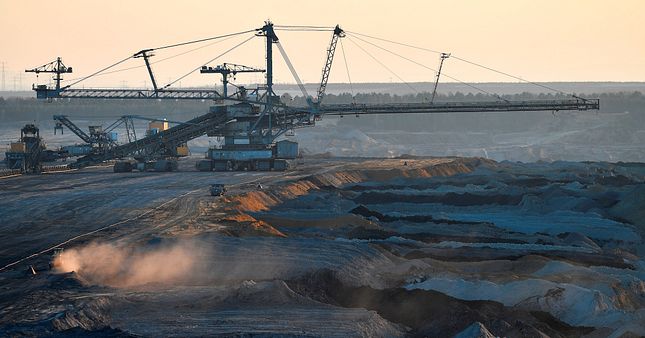
The EP Group earns a lot of money from German lignite. But whether there will be anything left to remediate the area after the coal phase-out in 2038, is doubtful.
No energy source is more climate damaging than lignite. And even if Germany plans to have parted ways with this inferior variety of fuel by 2038, a Czech billionaire is currently celebrating its last hurrah in the Lusatia region of eastern Germany.
Daniel Křetínský has a fortune estimated at $9.6 billion by the US business magazine Forbes. He not only owns shares in a top London football club, but also controls the EP Group, which has a trading branch in the coal epicentre of Zug, Switzerland, that primarily sells “transitional fuel”. With this neologism, the company is trying to whitewash the dirty coal from the five German open-cast mines it runs.
Meanwhile, numerous environmental organizations warn that the coal phase-out will be difficult for the eastern German region. The follow-up costs of lignite mining, according to Greenpeace Germany between €5 and 10 billion, are currently barely covered. Křetínský’s coal companies are also said to be short of money for this, as it has allegedly been skimmed off using “creative accounting” and accumulated elsewhere in his Kafkaesque-looking company construct. All that seems to be left are flimsy company shells, with no resources available to finance the necessary recultivation of the old mine sites.
One particular concern is that the water shortage already bothering the coal regions is expected to get worse after 2038 due to global warming. Will the billionaire investor have made a run for it by then?
Sources
- Greenpeace Germany (2024): Rekultivierungskosten in der Lausitz [Recultivation costs in Lusatia]. Last accessed on 15th May 2025.
- Konzeptwerk Neue Ökonomie (2024): Braunkohle-Folgekosten und Wasserkrise: Zeit für einen Kurswechsel! [Lignite follow-up costs and water crisis: time for a change of course!] Last accessed on 15th May 2025.
- Table Media (2024): Kohleausstieg: Verdacht der Gewinnmitnahmen bei der Leag [Coal phase-out: suspected profit-taking at Leag]. Last accessed on 15th May 2025.
- EP Resources (2025): Transitional Fuels. Last accessed on 15th May 2025.
- Forbes (2025): Profile Daniel Kretinsky. Last accessed on 15th May 2025.
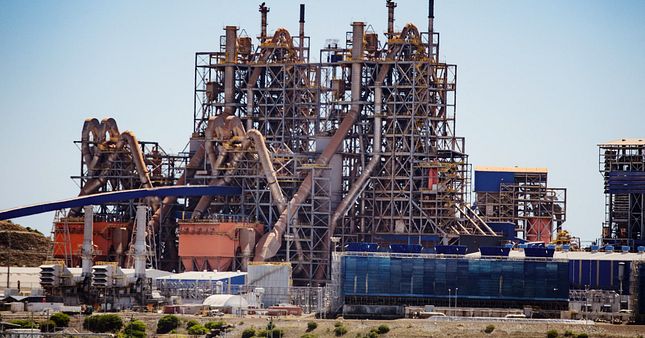
Nickel is a highly political issue in New Caledonia. Instead of taking responsibility for their indigenous employees, Glencore and Trafigura are abandoning them.
In New Caledonia, the struggle for independence is closely linked to nickel. This raw material is found in up to a third of the land mass of this archipelago located in the Pacific, which has belonged to France since its colonization in 1853. A special policy, entitled the “Nickel Doctrine”, should ensure that the indigenous Kanaks enjoy adequate prosperity from this natural wealth. But the fate of the New Caledonian nickel industry currently lies in the hands of two Swiss commodity giants.
Glencore and Trafigura both hold shares in one of the three major mining companies, whose products account for almost the entire export economy of the island. In early 2024, all the signs were that the two companies were bidding farewell. Due to the persistently low world market prices, Trafigura had announced an investment stop and Glencore even considered the closure of its mine.
A few months after these statements by the Swiss companies, the government in Paris announced an electoral reform and a long-pent-up conflict flared up. The Kanaks’ independence movement took to the streets, engaging in battles with the armed police. The latter opened fire on them, also with live ammunition. After weeks of confrontations, 14 people were reported dead.
The explosive political nature of their business does not seem to have changed Glencore’s strategy. The Swiss commodities giant has shut down its mine and laid off 1,200 workers, many of them from the indigenous population. In its latest commercials, the Zug-based company advertises nickel as being essential. It seems that the same cannot be said of its employees.
Sources
- Le Monde (2024): Nouvelle-Calédonie: le bilan des émeutes augmente à 14 morts [New Caledonia: death toll from the riots rises to 14]. Last accessed on 15th May 2025.
- Glencore (2024): Koniambo Nickel to Transition to Care and Maintenance. Last accessed on 15th May 2025.
- Bloomberg (2024): Trafigura-Backed Nickel Mine Seeks New Partner for Bailout. Last accessed on 15th May 2025.
- RTS (2024): Le nickel, un minerai essentiel au coeur de la crise en Nouvelle-Calédonie [Nickel, a key mineral at the heart of the crisis in New Caledonia]. Last accessed on 15th May 2025.
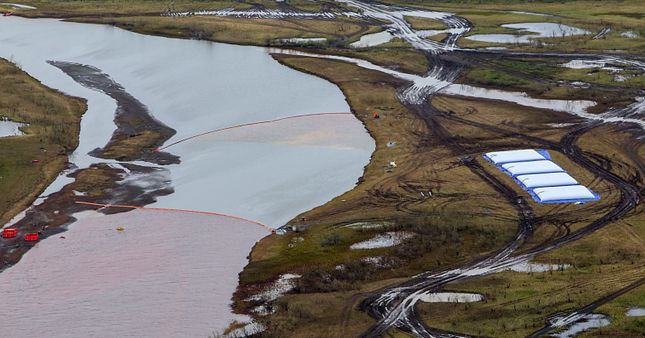
It was only a leaking diesel tank that, in 2020, revealed the decades of environmental destruction around this Arctic nickel mine. The relevant commodity is traded via Zug in Switzerland.
Since its founding as a Soviet labour camp 90 years ago, the poisoning of air, water and land always has been a part of the mining complex in Norilsk in northern Russia. After decades of acid rain, nowadays only tracts of bare land kilometres away provide evidence for the Arctic larch forests that once existed here. The plant, now operated by Nornickel, is by far the largest sulphur-dioxide polluter in the world. But the Russian company routinely also discharges tons of iron, cobalt and nickel into the adjacent rivers.
This creeping destruction of the environment has long been tolerated by the Russian authorities. But in May 2020, even they could no longer turn a blind eye to this killing of nature. After a diesel tank collapsed, almost 21,000 tonnes of fuel were discharged across the adjacent rivers, forming a deep red carpet. Nornickel had dragged its feet not only about carrying out maintenance on the plant, but also about taking necessary measures to curb water pollution. They then tried to prevent scientists and the media from documenting the dire consequences of a series of gross management failures.
In 2021, the environmental protection agency slapped a fine of around CHF 1.9 billion on the company belonging to oligarch Vladimir Potanin. But only a fraction of this Russian record fine for an environmental crime went to the indigenous peoples, whose livelihoods depend on the destroyed natural resources.
Since then, Nornickel is implementing a reparation strategy that the company launched in response to the diesel disaster. Whether that is more than greenwashing cannot be verified these days, as Russia has been under martial law since 2022. But the one thing for sure is that the Siberian nickel will continue to be traded in Zug, just as it has been for over 20 years.
Sources
- Public Eye (2020): Serien-Umweltsünder Norilsk Nickel vertreibt seine Metalle von Zug aus [Serial polluter Norilsk Nickel sells its metals from Zug]. Last accessed on 28th May 2025.
- Public Eye (2021): Serien-Umweltsünder Nornickel versucht verzweifelt, sich grün zu waschen [Serial polluter Nornickel desperately tries greenwashing]. Last accessed on 28th May 2025.
- Society for Threatened Peoples (2021): Nornickel: Toxische Geschäfte auf Kosten indigener Völker [Nornickel: Toxic business at the expense of indigenous peoples]. Last accessed on 28th May 2025.
- Inside Climate News (2021): ‘A Trash Heap for Our Children’: How Norilsk, in the Russian Arctic, Became One of the Most Polluted Places on Earth. Last accessed on 28th May 2025.
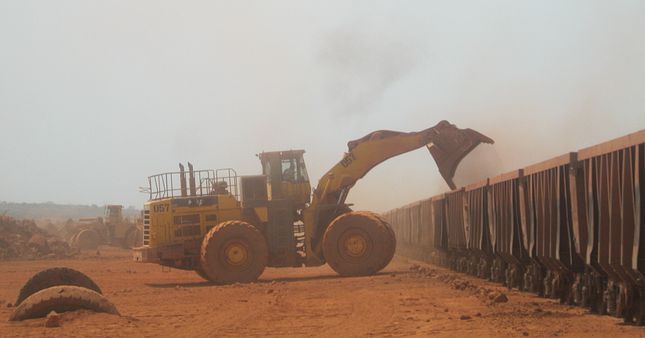
Blasting operations intended to expand a Rio Tinto Group bauxite mine are forcing entire villages in Guinea to move.
The constant rumblings, sounding like thunder, have made life unbearable for the residents of the Sangaredi mine. The explosions caused by the mining company are said to have advanced up to 500 metres towards their village and resulted in houses collapsing, dusty air and dried up water sources.
Since 2016, the consortium based around the British-Australian mining giant Rio Tinto, which has a trading arm in Zurich, has been continuing the expansion of its bauxite mine in Guinea by detonating several thousand tons of explosives every year. The aim is to clear an area twice the the city of Geneva to make way for the mine. Contributions to the financing of this project include a loan from the World Bank for more than $200 million dollars.
Because of its importance for the automotive industry, aluminium-ore bauxite is considered a critical raw material in the EU. But Guinea’s population sees only the downside of the growing interest in the country’s mineral resources. Even though the country is one of the world’s largest bauxite producers, its daily average per capita income is only around three Swiss francs.
When residents of the village of Hamdallaye had to make way for the mining company during the corona pandemic, they were offered one of its slag heaps as a new place to live. Out of necessity, they had agreed to resettle there. Residents of other villages have also reported that their land rights have been ignored. Currently, the communities are fighting their case in proceedings before the World Bank’s complaints office. Against the disregard for their land rights, against blasting, and against the destruction of the environment.
Sources
- FIAN Deutschland (2024): Guinea: Menschenrechtsverletzungen durch rücksichtslosen Bauxit-Abbau. Der Fall Sangaredi. [Guinea: Human rights violations through ruthless bauxite mining. The Sangaredi case.] Last accessed on 16th June 2025.
- CAO Ombudsman (2019): Case Tracker Guinea: CBG-01/ Sangaredi. Last accessed on 16th June 2025.
- Inclusive Development International (n.d.): Guinea: Demanding a fair deal for communities from Alcoa-Rio Tinto bauxite mine. Last accessed on 16th June 2025.
- ADREMGUI, IDI, CECIDE (2020): The Relocation of Hamdallaye Village in the Midst of Covid-19. How CBG is Failing to Meet the IFC Performance Standards. Last accessed on 16th June 2025.
- Human Rights Watch (2018): “What Do We Get Out of It?” The Human Rights Impact of Bauxite Mining in Guinea. Last accessed on 16th June 2025.
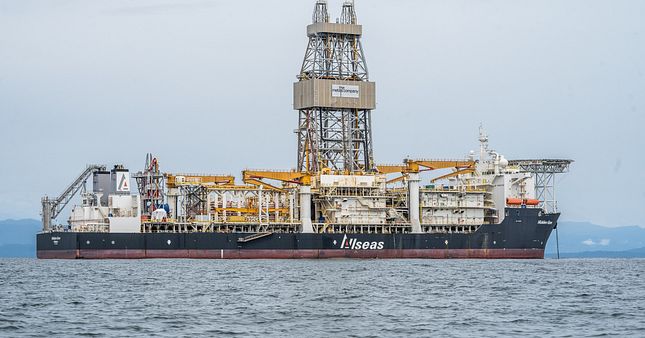
In search of new metals, the Fribourg-based Allseas is pushing the frontier of extractivism to the depths of the Pacific Ocean. Its underwater robots threaten to destroy an ecosystem yet to be discovered.
At a depth of more than 4,000 metres, far from sunlight, the pressure muffles also any sound. Only a few largely unknown species produce their own glow. The Clarion-Clipperton zone is in the very middle of the Pacific and the place where the next rush in the mining industry is happening, as underwater robots, far from prying eyes, scrape and suck up the ocean floor.
Deep-sea mining promises an “abundance” of nickel, manganese, cobalt or copper for the global race towards electrification. The shoulders of Allseas’ engineers bear the weight of this corporate pledge. Based in Châtel-Saint-Denis (FR), Switzerland and specializing in the construction of offshore oil platforms and underwater pipelines, the company has joined forces with the Canadian The Metals Company (TMC), of which it owns under 20 percent, to deploy its maritime “mega-vacuum cleaners”.
Since 2022, they have brought a few thousand tonnes of metals to the surface, with plans to progress to the industrial phase by late 2025. Glencore as a former TMC shareholder secured half of the supply back in 2012. The companies’ plans are based on minor scientific evidence, while posing major ecological risks, including the destruction of entire ecosystems. In 2023, nearly 1,000 scientists signed a letter calling for a moratorium on deep-sea mining. 38 countries, including Switzerland, support this measure.
In late July 2025, the assembly of the International Seabed Authority failed to agree on a “marine mining code”, highlighting the tensions between member states. The United States have announced to go alone. A few months earlier, Donald Trump had drafted an executive order allowing large-scale extraction of minerals, also in international waters. This would mean good business for some in Switzerland.
Sources
- Greenpeace (2025): Governments have yet to rise to the moment and vote in favour of a moratorium on deep sea mining. Last accessed on 9th September 2025.
- Reuters (2023): The promise and risks of deep-sea mining. Last accessed on 9th September 2025.
- Le Temps (2023): Des firmes suisses misent sur une exploitation minière des fonds marins. Last accessed on 9th September 2025.
- Swiss Federal Council (2025): Response to urgent question “Exploitation minière en haute mer. La Suisse doit s'engager pour le respect du droit international!" Last accessed on 9th September 2025.
16th September 2025, Manuel Abebe and Adrià Budry Carbó
An ever-increasing number of Swiss commodity traders are becoming owners of industrial-scale mines. Having made huge profits during recent crisis periods, these mining barons are investing billions as they systematically make inroads into the production of coal, copper or cobalt. This vertical integration is allowing them to boost their profit margins and their influence on the commodity markets. Traders are turning into powerful commodity conglomerates, exercising tight control over the entire value chain from mining operations to sales. This also confers on them a greater responsibility to protect human rights and the environment. Public Eye has already described this trend among agricultural commodity traders in terms of the plantations they control; now it is also becoming apparent in the energy and metals sectors.
Glencore is the undisputed number one among Switzerland’s mining barons. Since it took over Xstrata in 2012, the group has not only run its global trading business from its lavish headquarters in Zug, Switzerland, but also the operation of dozens of mines. And it’s not alone in adopting this strategy. In the meantime, numerous mining companies within its gravitational field – such as Vale, BHP and Trafigura – enjoy the tax privileges and the relaxed regulatory climate prevailing in Switzerland as a major commodity trading centre.
To gauge how heavily involved Switzerland now is in the mining business, Public Eye has identified 199 active mines (including a deep sea project site) and mapped them with pinpoint accuracy. They are owned by 25 Swiss commodity traders, which are therefore also involved in mining their products. The extensive research – undertaken by inspecting commercial registers, annual reports, databases, satellite images and numerous other open sources – proves that Swiss commodity traders are currently engaged in digging, drilling and mining for fossil fuels such as coal, as well as for new “transition” metals such as copper and cobalt, on six continents.
In these places, mostly located in remote and low-income regions, which depend on palatial control centres on the shores of Lake Geneva, Zug and Lugano, we also heard many accounts concerning social and environmental grievances in the mining sector. A selection of these stories is told next to the exclusive world map of Swiss mines. The ten accounts relate to coal mines that are scheduled to continue operating until 2070, contrary to all climate policy agreements. To nickel extracted in areas where the police respond to unarmed resistance with live ammunition; to plans to carry out highly sensitive deep-sea mining; or to the mining of copper, whose production entails the depletion of scarce water reserves.
Operating on six continents
More than half of Swiss-owned mines are located in Latin America, Africa or Asia. Take Brazil, for example, where we found the second largest number of mines. The mining giant Vale, which is based there, channels its entire trading business through a company located in the Swiss canton of Vaud, which we therefore consider to be a Swiss trader. In the last 10 years, two dams from its more than 20 iron-ore mines have burst, causing several hundred fatalities due to the resulting meter-high mudslides. In South Africa, which generates more than two-thirds of its energy from coal, several Swiss commodity traders are investing in new mines to extract this climate-killer instead of promoting renewable power sources. Such investments render these companies jointly responsible for preventing this vast country from weaning itself off fossil fuels.
Countries whose revenues are heavily dependent on raw material production are particularly affected by the market concentration among a few corporations. The Democratic Republic of Congo (DRC), for instants, depends for a third of its revenue on this key sector. The DRC is the world’s largest producer of the metal cobalt, which is becoming increasingly sought-after because it makes batteries more powerful, while preventing them from exploding. In 2024, three Swiss commodity companies controlled more than 70 percent of the country’s cobalt production. By doing so, they influence the market price and ultimately also how much the DRC retains of its natural wealth.
In recent years, the mining barons have significantly stepped-up cobalt production. This is especially true of the Chinese group CMOC, whose trading arm IXM is based in Geneva. To counteract the resulting price collapse, the DRC imposed a cobalt export ban in 2025. In spite of this, mining companies are still in full production, which is likely to depress the country’s export earnings in the long term. This is only the latest episode in the country’s tale with the resource curse, highlighting the imbalance of power between corporations and producing nations.
Swiss commodity traders play a prominent role in industrialized regions of the world, too. In Australia with its extensive coal and iron deposits, traders operate a total of 40 mines, making the country their favourite destination. In 2023, Public Eye reported on how the coal deals made “down under” by Swiss companies jeopardize the land rights of indigenous Aboriginal peoples. Mining barons are also on the rise in North America and Europe. Take Trafigura, for instance, one of the top traders in terms of turnover, which spans a growing network of zinc mines in the USA, Spain and Finland. This much-coveted metal protects iron from corrosion, while also helping the controversial oil trader add more shine to its halo.
Extraction of new resources …
Electrification of the global economy is also ramping up demand sharply for other metals and minerals, in addition to cobalt and zinc. This is the case with copper, which is needed for the expansion of power grids or in wind-turbine generators. Likewise nickel, offering the benefit of enabling batteries to store more energy in less space. And the aluminium ore bauxite, which plays a key role not only in the automotive industry, but also in other future material-intensive applications.
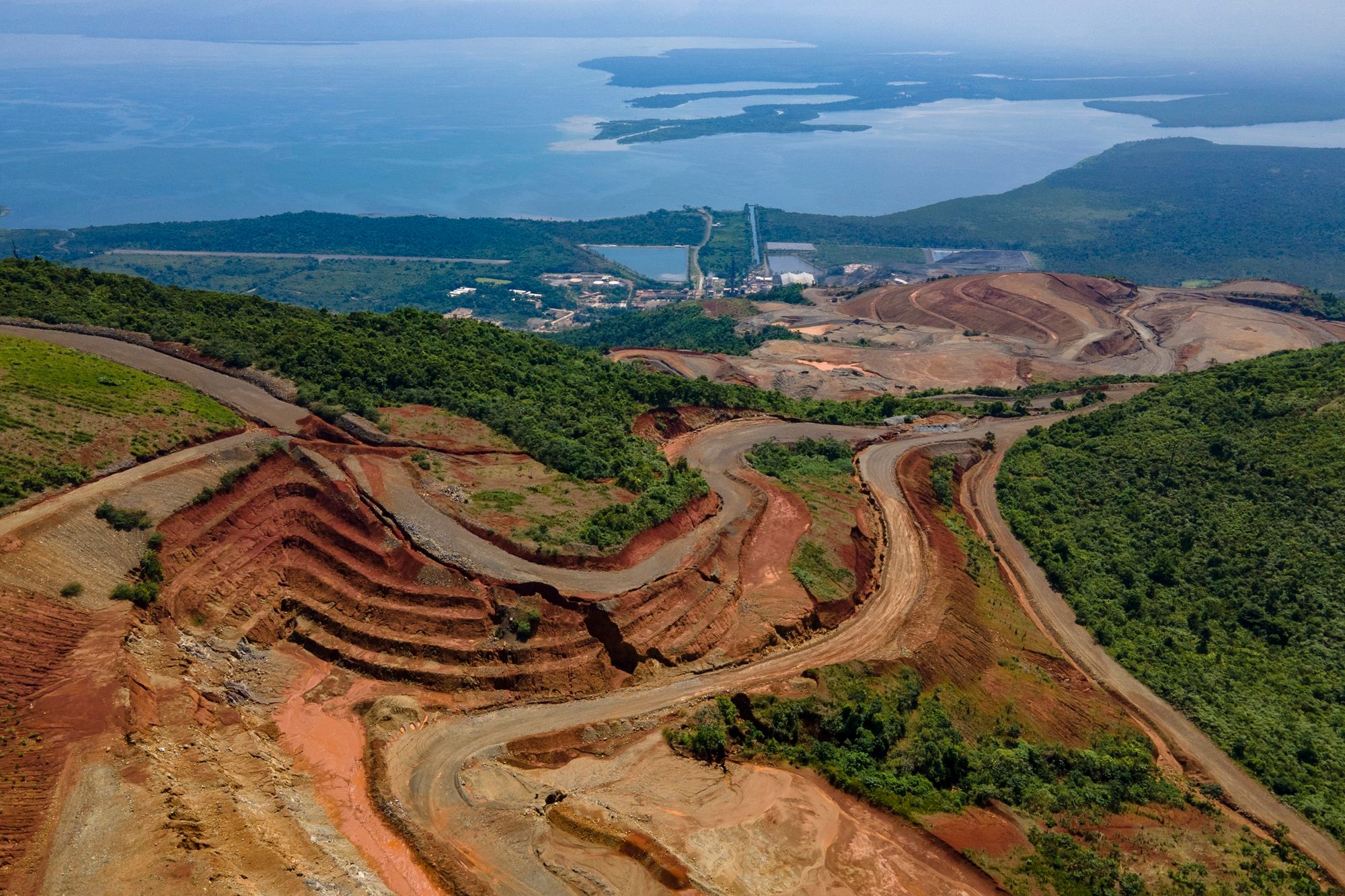 ©
Carlos Alonzo/AFP
©
Carlos Alonzo/AFP
Because of their vital function in the energy transition, these resources are also referred to as transition minerals. The growing demand for these minerals is highlighted by the long series of geopolitical projects that all the major players, from the USA and the European Union to China, are currently pursuing. This strong strategic interest shown by various states has not gone unnoticed by Swiss commodity traders either; some have even lobbied for it. They are now well prepared, thanks to the numerous investments that have been made. More than a third of the mines we have found are already set up for mining transition minerals.
Swiss commodity traders are digging for copper, one of the most valuable metals, in a total of 28 mines. This includes the Escondida mine in Chile, the world’s most productive copper site. The five largest Swiss mine owners have currently all invested in the mining of this sought-after metal. However, we did not find, as part of our investigation, any Swiss investments in the mining of lithium, which offers just as promising prospects. The companies prefer instead to forge ahead with their nickel and zinc operations. The first mines for extracting rare earth metals are also already in Swiss hands.
More infos
-
Scope and limits of analysis
This map aims to completely cover the sector. Still, there are three factors accounting for the fact that some mines controlled from Switzerland may be missing. The first factor is that the situation in terms of available data on the commodities sector is still very poor, especially in mining. Some companies publish neither annual reports nor any other public information about their mining activities. Secondly, this map provides only a snapshot of the situation as of July 2025. Mines that have been in operation for years, but have since been sold, do not appear; neither do new exploration projects whose production output is not yet on an industrial scale. And thirdly, only mines in which Swiss commodity traders demonstrably hold shares are recorded. These may be fully controlled mines, joint ventures or mines involving minority interests.
The map does also not show all those mines with which Swiss commodity traders have concluded long-term off-take agreements. These important and often secret deals provide traders with exclusive purchase rights, thereby enabling them to exert decisive influence on production. If any grievances arise, reference is regularly made to such contracts with suppliers, so that traders can deflect responsibility from themselves. Furthermore, we have not mapped the infrastructure supporting the processing of mined products, such as smelters. Oil and gas production facilities were also not part of our investigation.
... raises the old problems at local level
While the processing of commodities into more climate-friendly products continues to grow, there seems to be barely any improvement in the human-rights situation in mining countries. This is highlighted by a study undertaken by the international expert network Business & Human Rights Resource Centre (BHRRC), which assessed reports from around 250 mines involved in the production of transition minerals. More than three-quarters (77 percent) of them have faced at least one allegation of human and labour rights violations or environmental offences. Several dozen mines owned by Swiss commodity traders are also affected, as a comparison of the BHRRC study with the map of Public Eye shows.
The most common grievances are expulsions and the curtailment of land rights. Exploration licences often cover more than several thousand hectares. In such land-intensive open-cast mining, agricultural land and entire villages are often taken away from the local population. Indigenous communities are particularly affected by forced expropriations, as highlighted in the warning from the Swiss NGO Voices. Already, 54 percent of mines extracting transition minerals are located nowadays on or near Indigenous territories. The pressure exerted on their rights and those of rural population groups is likely to increase further due to this new boom.
However, the BHRRC study also mentions numerous allegations of rights violations against employed miners, who depend on their income from mining. They work under the toughest physical strain, with injuries and fatalities being a common occurrence. As is the case with the production of other commodities, precarious labour conditions, excessively long working days and inadequate incomes are also widespread in the mining sector. Trade unions that campaign against such grievances are put under pressure in many countries.
-
© Muhammad Fadli / Panos
-
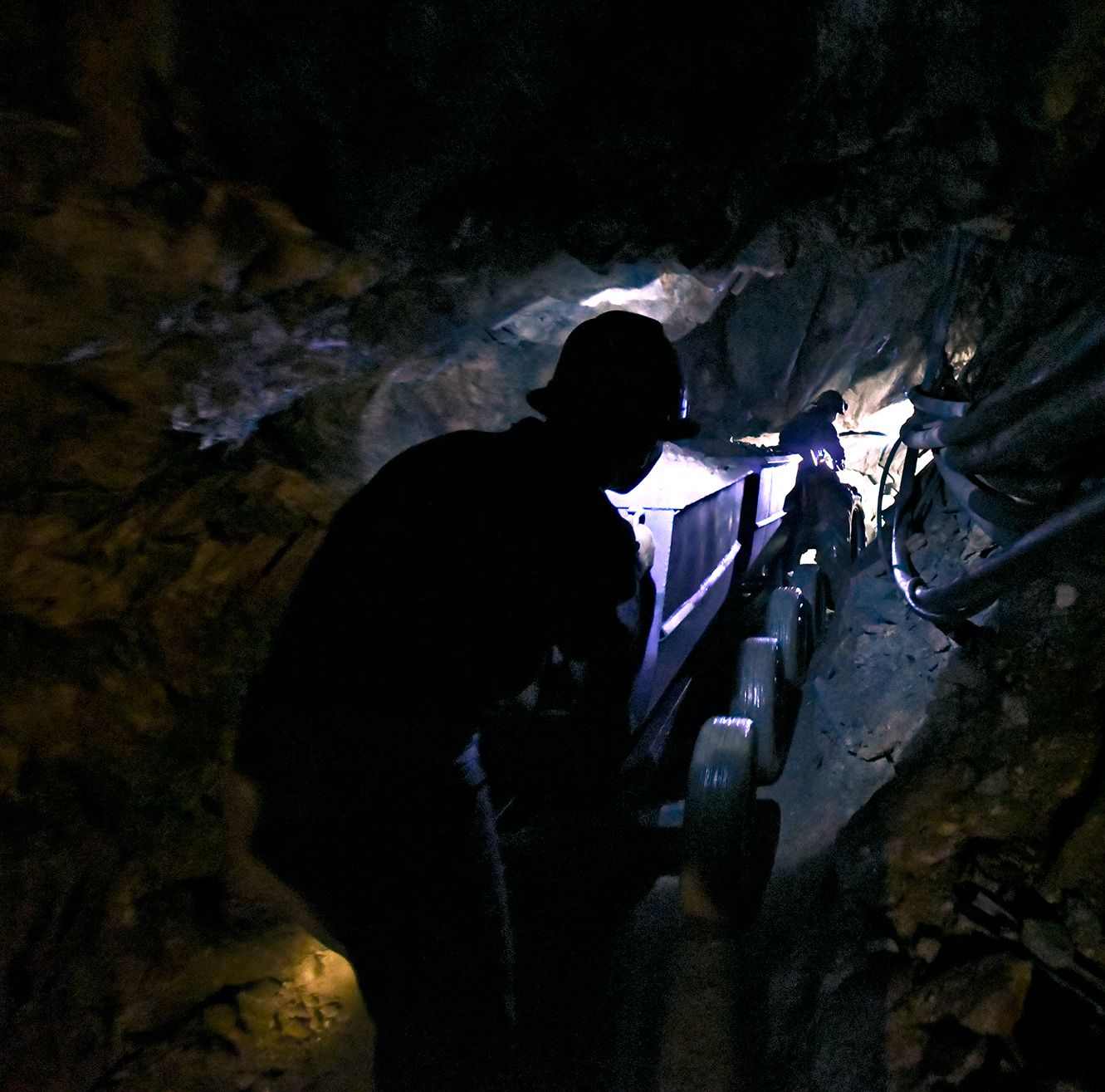 ©
Christian Lombardi/Public Eye
©
Christian Lombardi/Public Eye
-
 ©
Matthew Abbott/Panos
©
Matthew Abbott/Panos
The energy transition is also unlikely to bring about any improvements in the environmental damage caused by the mining sector. This becomes particularly visible in nickel production. In Indonesia, for example, companies are clearing rainforest for their mining operations at a staggering rate. The huge scale of water-use and pollution is also part of the damage caused by the extraction of these metals. The same applies to air pollution. A Russian company that trades its nickel in Zug has turned a city in Siberia into the world’s number one hotspot for acid-rain inducing gas sulphur dioxide.
In several of the documented cases, these problems were tolerated by the respective governments. Numerous communities living around the mines owned by the commodity traders are also defending themselves against their systematic strategy of turning a blind eye. Anti-corruption activists deplore the millions upon millions of francs their countries have lost due to bribes paid by the extractive sector to local or national elites. Indigenous communities protest the disregard of their land rights, while trade unions are negotiating the future of employees with commodity companies following mine closures. This resistance to mining companies has entailed growing risks in recent years. In 2023, 25 human-rights activists were killed in connection with mining projects, far more than in any other sector, according to the British NGO Global Witness.
More infos
-
A just energy transition
The concept and idea of a just energy transition mean a transition to a climate-friendly economy where human rights are guaranteed, the environment is respected, and sustainable development is facilitated. Not only when phasing out old fossil energy sources, but also when promoting new climate-neutral alternatives. This process affects individuals, local communities, geographical regions or entire countries. Ways of contributing to this include, for example, retraining and acceptable follow-up solutions for employees in fossil-fuel sectors, the protection of land rights during the expansion of mines for transition minerals, extensive reclamation after the closure of coal mines or new prospects for regions and countries which are economically dependent on the production and export of fossil energy resources.
Coal, the familiar friend
While Swiss commodity traders are preparing for the boom in the mining of transition minerals triggered by climate change, their current activities continue to revolve around the biggest climate-killer of all: coal. It’s being extracted on all six continents and in a third of all mines we have mapped, making it the most mined commodity overall. In addition to various open-cast lignite mines, the largest coal mine in Latin America or numerous coal tunnels in North America, commodity traders have also grabbed mines for which Indonesian rainforest was sacrificed.
This dominant position has underpinned Public Eye’s criticism since 2022: Switzerland is the linch-pin of the global coal trade, thereby benefiting financially from the most climate-damaging of all fossil resources. A part of the business has been in peril for several years – Russian coal, whose trade flourished in Switzerland until the invasion of Ukraine. In the meantime, this business has become subject to sanctions, which is why Public Eye did not include dozens of Russian coal mines in this investigation, even though their owners had been selling their coal via Switzerland for years. Several of these trading companies continue to exist, as Public Eye found out a few months ago when visiting their office addresses in Zug. They don’t seem to have bid farewell yet to their formerly lucrative adopted home.
Meanwhile, other Swiss traders are sticking with coal, often despite assurances to the contrary. Three years ago, Public Eye called for it to be phased out by 2030. We have not found any plans for this to happen yet. Instead, coal companies have found another bogus argument for delaying the phase-out: metallurgical coal. The steel industry needs this type of coal to operate its blast furnaces. Because the energy transition will also swallow up tons of steel, traders are reinterpreting their coal as a raw material supporting a more sustainable future. Glencore, for example, is using this argumentative pivot to justify its mining of coal until 2070.
Switzerland, the tax and investment haven
Switzerland is an attractive location for traditional commodity traders, but also for global mining companies. The main reason is the advantage of marketing the commodities they have produced themselves in a tax haven like Switzerland. This is perfectly illustrated by Vale. As early as 2013, Public Eye had traced how the world’s largest iron-ore company used Switzerland for its aggressive tax avoidance. As a result, this income was missing in the mining countries. Tracking the size of these losses is almost impossible in the financially notoriously discreet Switzerland.
Switzerland is also of interest to companies wishing to hedge their mining investments. Behind some Swiss letterboxes, there is a coal mine, a copper mine or a production site for rare-earth metals hidden. In addition to the tax benefits, there are a many other factors that make Swiss holdings a safe haven for mining companies. The first one is that, as a stable financial centre, Switzerland guarantees the necessary security for long-term investments. Secondly, Switzerland is a centre of financial secrecy that allows many coal investors to conceal their assets.
And last, but not least, Switzerland enables its companies to sue other states. Its tight network of investment-protection agreements provides companies with access to an opaque system of secret tribunals. Mining operators can sue countries at a whim for damages running into millions. For example, Glencore has already dragged the Colombian state into several costly proceedings before such courts in connection with its mining operations.
Switzerland needs answers for the future
As long as high-income countries like Switzerland fail to limit their growing consumption of resources, mining of transition minerals will continue to increase in keeping up with the electrification of the global economy. Swiss commodity traders already own many of these mines and are constantly expanding into new projects. Among all this, respect for human rights and the environment should be paramount. But when looking forward to a hopefully cleaner future, the dirty present situation must not be forgotten: Coal is still by far the main resource extracted in Swiss mines.
The world map displaying their mines shows the increasingly important role that Swiss commodity conglomerates now play in the extraction of vital energy resources. These corporations influence world market prices and sometimes directly control the money tap of entire production countries. Their stories from the mining regions underline how human rights and environmental standards are often flouted. To prevent this from continuing or any obstruction hampering a just energy transition, Switzerland must regulate its commodity trading companies. Otherwise, it too runs the risk of soon becoming subordinate to its mining barons.
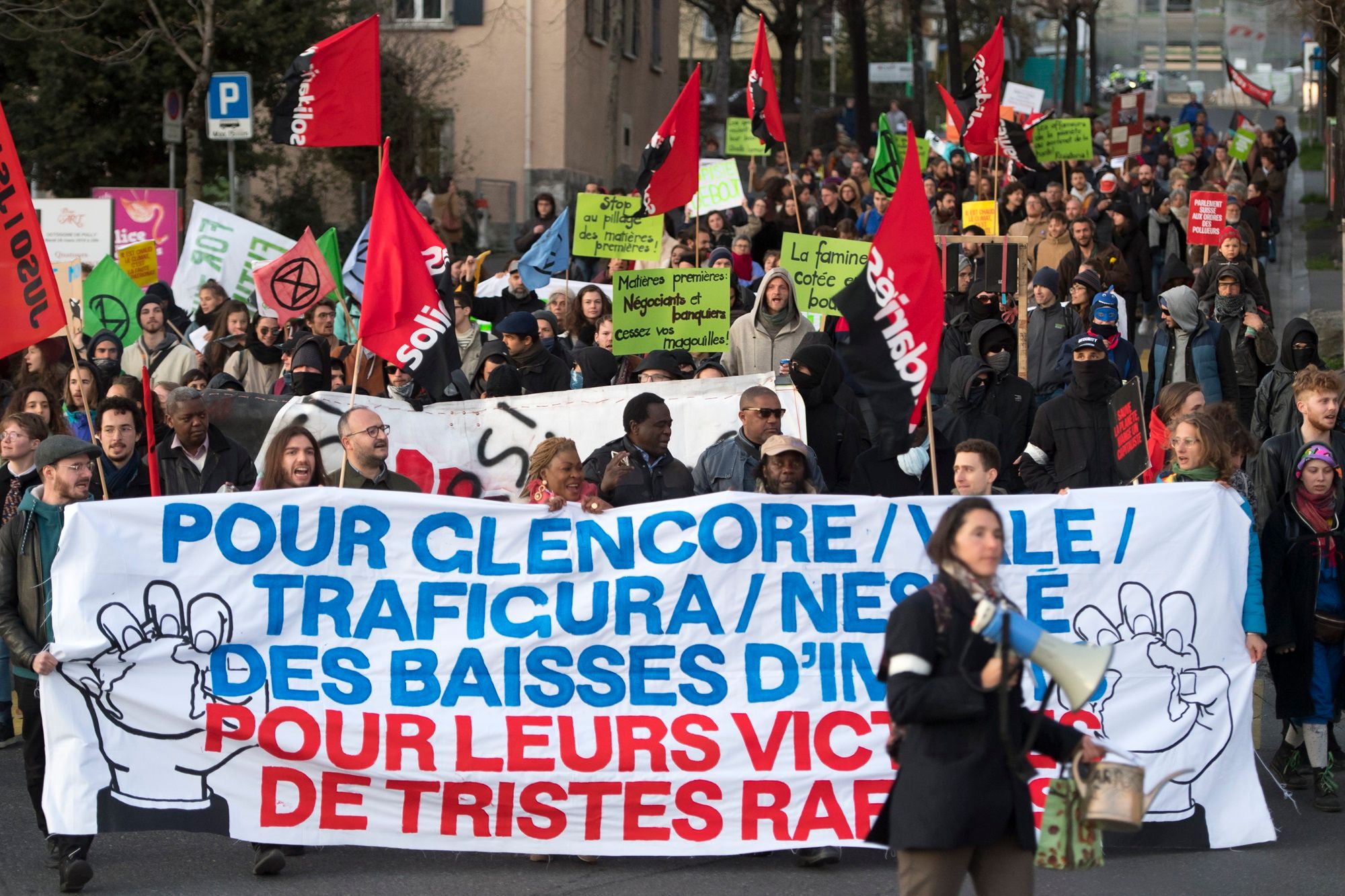
Public Eye’s demands
- To finally obtain an overview of the mining operations of its trading companies, Switzerland must systematically record the origin of all commodities traded in Geneva, Zug or Lugano.
- To guarantee compliance with the necessary due-diligence and transparency obligations when mining transition minerals, and entertaining corresponding business relationships, Switzerland needs a public commodity market supervisory authority.
- To protect human rights and the environment in mining countries, Switzerland must introduce effective corporate responsibility legislation.
- To demand a binding coal phase-out from its raw materials companies, Switzerland must require transparent and comprehensive climate reporting, clear transition plans, and financial provisions for this purpose.
- To enable a just distribution of earnings in the extractive sector and cushion its social and environmental consequences, Switzerland should promote international solutions instead of joining the geopolitical race for strategic commodities.






